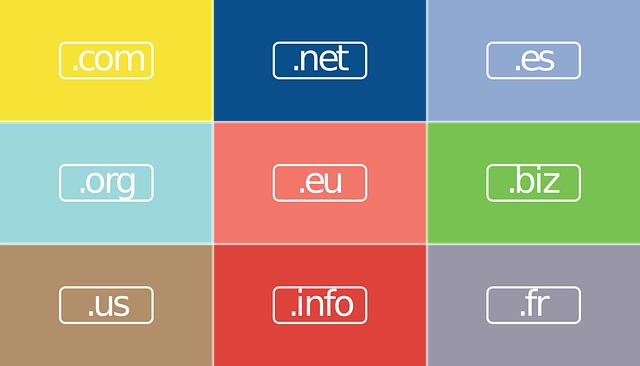Table of Contents
- Understanding the Basics of Domain Flipping
- Mastering the Art of Domain Valuation
- Strategies for Finding Profitable Domain Names
- Avoiding Common Pitfalls in Domain Flipping
- Advanced Techniques for Maximizing Profits
- Q&A
- In Conclusion


Understanding the Basics of Domain Flipping
Diving into the world of domain flipping requires a solid grasp of its foundational elements. Essentially, domain flipping is akin to digital real estate investment, where individuals purchase domain names with the intent to sell them at a higher price. This process involves identifying domain names that have the potential to appreciate in value over time. A key challenge is distinguishing between what seems promising and what truly holds long-term value. Potential trends, current market demands, and the simplicity or catchiness of a domain can significantly influence its resale value.
- Research: Invest time in researching domain marketplaces and understanding market trends.
- Valuation: Learn how to appraise a domain’s worth based on factors such as domain length, keywords, and branding potential.
- Negotiation: Develop negotiation skills to effectively communicate with potential buyers and secure profitable deals.
Many successful domain flippers begin with purchasing unexplored niche domains or expired ones due to their untapped potential or existing web traffic. However, it’s also critical to remain cautious and avoid overestimating a domain’s resale potential. Monitoring industry news and utilizing tools like Estibot or NameBio can aid in evaluating domain values and trends. Below is a brief comparison of popular tools for evaluating domain value:
| Tool Name | Features | Price |
|---|---|---|
| Estibot | Automated appraisals, market trends | Subscription-based |
| NameBio | Historical sales data, domain analytics | Free & Premium options |
| GoDaddy Appraisals | Quick valuations, buy/sell recommendations | Free |


Mastering the Art of Domain Valuation
In the exhilarating world of domain flipping, the stakes are high, and the rewards can be substantial. Understanding the factors that contribute to a domain’s value is crucial for making informed investment decisions. The worth of a domain hinges on several aspects such as length, relevance, and brandability. Shorter domains, particularly those with fewer than eight characters, generally attract higher interest due to their memorability and ease of use. Additionally, domains closely aligned with trending industries or high-demand niches naturally see an uptick in valuation.
Experts often rely on a combination of tools and instincts to appraise domain names accurately. While automated valuation platforms can provide a quick estimate, nothing beats a hands-on analysis. Consider leveraging tools that offer data-driven insights into metrics like search volume, cost-per-click (CPC), and industry trends. Here’s a short list to focus on when evaluating a domain’s potential:
- Keyword Relevance: Does the domain serve a niche with significant online traffic?
- Extension Value: Popularity and reliability of the domain extension (.com vs. .net, etc.)
- Historical Performance: Previous sales data of similar domains
- Market Demand: Current interest from potential buyers
| Factor | Impact on Value |
|---|---|
| Short Length | High |
| Brandability | High |
| Industry Trends | Medium |
| SEO Metrics | Low to Medium |
Adopting a strategic approach when purchasing domains is vital to long-term success. Savvy investors keep an eye on emerging trends and adapt their portfolios accordingly. The ultimate goal is to identify domains that currently hold latent potential but can be transformed into highly valuable online real estate. Networking with industry insiders and maintaining an active presence in domain forums can provide indispensable insights into which domains are on the rise. Always be prepared to pivot your strategy as new trends and technologies reshape the digital landscape. This foresight, combined with a deep understanding of valuation fundamentals, will propel your domain flipping ventures to dizzying heights.


Strategies for Finding Profitable Domain Names
Discovering lucrative domain names requires a blend of research, intuition, and understanding of market trends. Comprehensive keyword research is fundamental; using tools like Google Keyword Planner or SEMrush can help identify terms that not only are high in demand but also illustrate emerging trends. Look for niche areas where competition is lower, making it easier for your domain to attract potential buyers. Additionally, consider leveraging expired and expiring domains that have previously hosted websites. These often come with established backlinks and some level of authority, offering an edge in the flipping market.
- Use Domain Name Generators: Platforms like Nameboy and Lean Domain Search can spark creative ideas by combining relevant keywords and displaying available options.
- Stay Ahead with Industry Trends: Keeping up with current technology, pop culture, and business trends can inform your selections, helping you target domains that may soon see a spike in demand.
- Think Short and Memorable: Shorter domain names are easier to remember and type, increasing their potential market value. Aim for terms that are intuitive and fit well with current or anticipated market trends.
Once keywords and trends are set, evaluate the domain’s potential resale value. Check existing sales platforms like Flippa and Sedo to gauge market prices. Use similar domain sales as benchmarks but remember that intrinsic factors such as domain history and ease of pronunciation can significantly impact value. Employ a basic framework for assessment:
| Factor | Importance |
|---|---|
| Keyword Relevance | High |
| Length | High |
| Brandability | Medium |
| Historical Traffic | Medium |
Having a structured approach to evaluating domains will improve your chances of success in the domain flipping arena, equipping you with insights needed to make informed decisions and seize profitable opportunities.


Avoiding Common Pitfalls in Domain Flipping
In the pursuit of profit through buying and selling domains, many newcomers fall into traps that can be easily avoided with a bit of foresight. One of the most pervasive mistakes is overvaluing a domain. Avoid emotional attachment and ensure your valuations are based on metrics like search volume, backlinks, and market trends. Conduct thorough research and use domain appraisal tools to get an objective estimate. Coupled with understanding market dynamics, these strategies help establish a realistic price point and prevent long-term financial losses.
- Ignoring current trends: A domain might have had a past life, but its current relevance is what will drive buyers to you. Keep an eye on emerging sectors and industries for timely acquisitions.
- Neglecting proper research: Without understanding market demands or being aware of legal pitfalls, such as trademark issues, your investment could be at risk. Always verify domain history and legality before purchase.
- Failing to consider holding costs: Domain maintenance often incurs annual fees. Calculate these costs into your investment strategy to ensure profitability isn’t diminished by recurring expenses.
Another common error is lacking negotiation skills. Even if you’ve priced it fairly, knowing when to stand firm and when to compromise can impact your bottom line significantly. Often, potential buyers may attempt lowball offers; being skilled in negotiating will help you secure a profitable margin. Educate yourself on negotiation tactics, anticipate common buyer arguments, and prepare your responses in advance to stay ahead in the game.


Advanced Techniques for Maximizing Profits
Exploring the world of domain flipping can reveal a spectrum of advanced techniques that seasoned flippers use to maximize their profits. One crucial way is by employing the practice of domain trend analysis. This involves researching current and emerging trends, such as new technologies, popular cultural phenomena, or upcoming events that could increase demand for related domain names. Tools like Google Trends, Keyword Planner, and social media analysis can be invaluable for uncovering these trends. When you can target a niche that’s about to gain traction, you’ll position yourself ahead of the curve, ready to capitalize when interest spikes.
Another powerful strategy is utilizing domain monetization before selling. By developing a simple but engaging website on the domain, incorporating affiliate links or pay-per-click ads, you create a revenue stream that not only generates income in the short term but also potentially increases the domain’s value at sale. Buyers are more inclined to pay a premium for domains that have a proven track record of generating traffic and income. Thus, effectively monetizing a domain can be an ingenious step towards enhancing its appeal and price point.
In the practice of fostering relationships within the domain community, networking can be key to success. Building a robust list of contacts—such as fellow domainers, brokers, and potential end users—can provide insights and opportunities that might otherwise be missed. Consider joining domain-specific forums, attending domain conferences, or participating in online webinars. To better illustrate the benefits of networking, here’s a simple table of potential network contacts and their advantages:
| Contact | Benefit |
|---|---|
| Domain Forums | Access to industry trends and peer exchanges |
| Domain Brokers | Assistance in securing high-value sales |
| Potential End Users | Targeted sale opportunities directly related to buyer needs |
Q&A
Title: Understanding Domain Flipping: A Comprehensive Q&A GuideQ: What is domain flipping? A: Domain flipping is the practice of purchasing domain names with the intent to resell them at a higher price. This investment strategy takes advantage of the growing demand for attractive domain names in the digital marketplace.
Q: How do I get started with domain flipping? A: To begin domain flipping, you need to:
- Conduct thorough research to identify valuable domain names.
- Register these domain names through a reliable registrar.
- Market your domains to potential buyers using online platforms or personal networks.
- Sell them at a profit by leveraging negotiation skills and market trends.
Q: What makes a domain name valuable? A: A domain name’s value is influenced by factors such as:
- Length: Shorter domain names are usually more desirable.
- Relevance: Domains that include popular keywords or industry-specific terms tend to attract more interest.
- Memorability: Catchy and easy-to-remember domains have an edge in the marketplace.
- Extension: Conventional extensions like “.com” are typically preferred over others.
Q: Are there any risks associated with domain flipping? A: Yes, domain flipping involves several risks, such as:
- Market Volatility: Domain prices can fluctuate, affecting profitability.
- Legal Issues: Purchasing domains with trademarks or legal implications can lead to disputes.
- Cash Flow: Domains may take time to sell, tying up your capital.
Q: How do I find potential buyers for my domains? A: To attract buyers, you can:
- Use Domain Marketplaces: Websites like GoDaddy Auctions, Sedo, and Flippa offer platforms for listing domains.
- Network in Industry Forums: Participate in online communities related to domain investing and entrepreneurship.
- Leverage Social Media: Use platforms like LinkedIn and Twitter to reach wider audiences.
Q: Can I flip domains part-time, or is it a full-time commitment? A: Domain flipping can be pursued both part-time and full-time. Many people start part-time, gradually transitioning to full-time as they gain experience and build a profitable portfolio. It largely depends on your goals and financial aspirations.
Q: What are some successful strategies for domain flipping? A: Successful domain flippers often:
- Follow Market Trends: Staying informed about emerging industries and popular terminology can help identify promising domain names.
- Diversify Investments: Spreading investment over a range of domains reduces the risk associated with market changes.
- Build Relationships: Establishing connections with other investors and industry professionals can open new opportunities.
Q: Where can I learn more about domain flipping? A: To deepen your understanding, consider online courses, webinars, and industry blogs dedicated to domain flipping. Engaging with veteran domain flippers can also provide valuable insights and mentorship.
This Q&A guide offers a snapshot of domain flipping, equipping you with the necessary insights to embark on this potentially lucrative venture. Remember, as with any investment, success hinges on diligent research and strategic execution.

